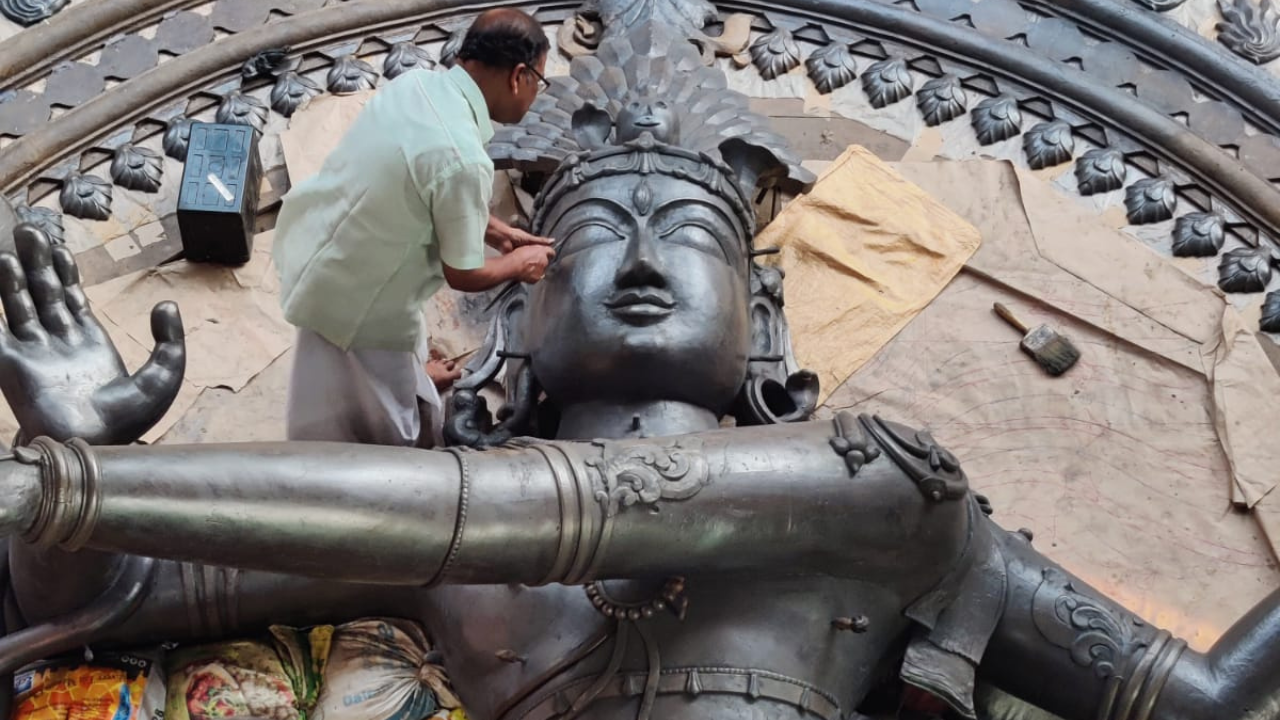The Nataraja statue, which combines in a single image Shiva’s role as creator, preserver, and destroyer of the universe and conveys the never-ending cycle of time, is quite a masterpiece. In 2014, it was installed outside CERN, the world’s largest particle physics laboratory in Switzerland and now, a 28-ft-tall version will greet dignitaries to Bharat Mandapam, the G20 venue in Delhi.
It was crafted by three brothers who hail from Swamimalai, a town in Tamil Nadu. “The G20 Nataraja will last centuries. In fact, it can easily last 1,000 years,” says Srikanda Sthapathy, second son of the late master-craftsman S Devasenapathy.
Situated on the banks of the river Kaveri, the small town of Swamimalai is famed for its bronze icons which sthapathys (sculptors) have been carving using the traditional lost-wax technique since the time of the Chola empire. Swamimalai bronze icons now have the coveted GI tag too.
Chola bronze statues are usually made of three to five metals — copper, brass and lead. Sometimes, silver and gold are added to make a ‘panchadhatu’ sculpture. “But the government of India wanted an ‘ashtadhatu’ Nataraja for the G20 summit. It is made of eight metals with the addition of mercury, iron and tin makes it very strong,” says Srikanda.
“The G20 one is the biggest traditional Natarajas in the world at 28 feet,” says Srikanda, a ninth-generation Swamimalai sthpathy. The three brothers today run Sri Jayam Industries to manufacture and export Chola bronzes around the world. “The sculptors in our family are known for the purity of the materials they use. We have never used second-grade stuff like gunmetal. We follow all the exact measurements and patterns as mentioned in the shilpasastras. And we make idols for Hindu temples around the world,” says Srikanda.
Explaining the highly meticulous lost-wax casting method, Srikanda says the wax model is first covered with a paste of alluvial soil from the Kaveri river bed. “In fact, the main reason why we always get the pattern right is because the soft soil is procured from the river bed situated one kilometer from the Swamimalai town. Even going 2km further down will not achieve the same result,” says Srikanda.
The G20 statue was transported over two days via a specially created green corridor of some 2,500km from Tamil Nadu to Delhi.
It was crafted by three brothers who hail from Swamimalai, a town in Tamil Nadu. “The G20 Nataraja will last centuries. In fact, it can easily last 1,000 years,” says Srikanda Sthapathy, second son of the late master-craftsman S Devasenapathy.
Situated on the banks of the river Kaveri, the small town of Swamimalai is famed for its bronze icons which sthapathys (sculptors) have been carving using the traditional lost-wax technique since the time of the Chola empire. Swamimalai bronze icons now have the coveted GI tag too.
Chola bronze statues are usually made of three to five metals — copper, brass and lead. Sometimes, silver and gold are added to make a ‘panchadhatu’ sculpture. “But the government of India wanted an ‘ashtadhatu’ Nataraja for the G20 summit. It is made of eight metals with the addition of mercury, iron and tin makes it very strong,” says Srikanda.
“The G20 one is the biggest traditional Natarajas in the world at 28 feet,” says Srikanda, a ninth-generation Swamimalai sthpathy. The three brothers today run Sri Jayam Industries to manufacture and export Chola bronzes around the world. “The sculptors in our family are known for the purity of the materials they use. We have never used second-grade stuff like gunmetal. We follow all the exact measurements and patterns as mentioned in the shilpasastras. And we make idols for Hindu temples around the world,” says Srikanda.
Explaining the highly meticulous lost-wax casting method, Srikanda says the wax model is first covered with a paste of alluvial soil from the Kaveri river bed. “In fact, the main reason why we always get the pattern right is because the soft soil is procured from the river bed situated one kilometer from the Swamimalai town. Even going 2km further down will not achieve the same result,” says Srikanda.
The G20 statue was transported over two days via a specially created green corridor of some 2,500km from Tamil Nadu to Delhi.
